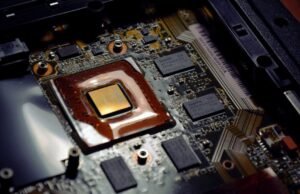AI Software and Hardware
Artificial Intelligence (AI) has emerged as a transformative technology in recent years, revolutionizing various industries and sectors. AI software and hardware play essential roles in enabling machines to simulate human intelligence and perform tasks that traditionally required human intelligence. In this article, we will explore the importance of AI software and hardware and their impact on various applications.
Key Takeaways
- AI software and hardware are crucial components that enable machines to simulate human intelligence.
- AI software includes algorithms, models, and libraries that facilitate machine learning and other AI techniques.
- AI hardware provides the computational power required to process massive amounts of data and perform complex AI tasks.
- AI software and hardware are driving advancements in healthcare, finance, transportation, and many other industries.
- The synergy between AI software and hardware is essential for the development and deployment of effective AI solutions.
AI Software
AI software encompasses a wide range of tools and technologies that facilitate machine learning, natural language processing, computer vision, and other AI techniques. **These software solutions** are designed to analyze and interpret complex patterns and data, enabling machines to make informed decisions. *One interesting example is deep learning algorithms, which use artificial neural networks to learn and recognize patterns in data.* AI software includes the following:
- Algorithms: Mathematical models that perform specific tasks or solve problems based on predefined rules and patterns.
- Machine Learning (ML) Libraries: Pre-built collections of algorithms and functions that simplify the development and implementation of machine learning models.
- Model Training Platforms: Platforms that facilitate the training of AI models using large datasets and parallel processing capabilities.
- Natural Language Processing (NLP) Frameworks: Tools that enable machines to understand and generate human language, enabling applications like chatbots and language translation.
- Computer Vision Libraries: Software that enables machines to analyze and interpret visual content like images and videos.
AI Hardware
AI hardware refers to the specialized hardware components and infrastructure required to support the computational and processing capabilities needed for AI tasks. **These hardware components** are designed to handle the massive amounts of data used in AI applications and perform the complex calculations involved. *One interesting aspect of AI hardware is the rise of dedicated AI chips, such as Graphics Processing Units (GPUs) and Tensor Processing Units (TPUs), which provide accelerated processing power for AI workloads.* AI hardware includes the following:
- Central Processing Unit (CPU): The main processor of a computer system, capable of executing general-purpose tasks and calculations.
- Graphics Processing Unit (GPU): Specialized hardware primarily used for rendering images and graphics, but also widely utilized for parallel processing in AI applications.
- Field-Programmable Gate Array (FPGA): Configurable hardware that can be reprogrammed to perform specific tasks, making it suitable for AI development and optimization.
- Application-Specific Integrated Circuit (ASIC): Custom-designed integrated circuits specifically tailored for AI tasks, providing high performance and energy efficiency.
- Tensor Processing Unit (TPU): Google’s custom-designed AI accelerator, optimized for machine learning tasks and widely used in AI research and applications.
AI Software and Hardware Synergy
AI software and hardware are not standalone entities but work in synergy to facilitate the development and deployment of effective AI solutions. The optimal combination of AI software and hardware is crucial for achieving high-performance AI applications. **The combination** of powerful AI hardware and efficient software algorithms enables faster processing, enhanced accuracy, and improved scalability. *For example, the use of GPUs for parallel processing significantly accelerates the training of deep learning models.* The synergy between AI software and hardware is essential for addressing the challenges of complex AI tasks and unlocking the full potential of AI technology.
| AI Software | AI Hardware |
|---|---|
| Algorithms | CPU |
| Machine Learning Libraries | GPU |
| Model Training Platforms | FPGA |
| Natural Language Processing Frameworks | ASIC |
| Computer Vision Libraries | TPU |
Applications and Impact
The combination of AI software and hardware has profound impacts across various industries and sectors. AI-powered solutions are transforming healthcare, finance, transportation, manufacturing, and many more domains. Some notable examples include:
- Healthcare: AI algorithms and hardware enable faster and more accurate diagnosis of diseases, personalized treatment plans, and AI-assisted surgeries.
- Finance: AI software and hardware facilitate fraud detection, algorithmic trading, and portfolio management, making financial operations more efficient and secure.
- Transportation: AI-powered systems enhance autonomous driving, traffic management, and predictive maintenance, improving safety and efficiency in transportation networks.
| Industry | AI Impact |
|---|---|
| Healthcare | Faster diagnosis, personalized treatment |
| Finance | Fraud detection, algorithmic trading |
| Transportation | Autonomous driving, traffic management |
As AI software and hardware continue to advance, the boundaries of what can be achieved with AI technology are continually expanding. The continued development and integration of AI software and hardware will drive further innovation in diverse fields and unlock new possibilities for human-machine collaboration.

Common Misconceptions
Misconception 1: AI Software Can Automatically Learn Everything
One common misconception about AI software is that it has the ability to automatically learn everything on its own. In reality, AI software requires input and guidance from humans to learn and improve.
- AI software needs training data to learn.
- Human involvement is necessary for initial set-up and ongoing monitoring.
- AI software can only learn within the scope of its training data.
Misconception 2: AI Hardware Is Always Expensive
Another prevailing misconception is that AI hardware is always expensive. While powerful AI hardware can be costly, there are a wide range of options available at different price points to suit various needs and budgets.
- Low-cost AI hardware options are available for basic applications.
- Cloud-based AI services can reduce the need for expensive hardware.
- AI hardware prices have been decreasing as the technology advances.
Misconception 3: AI Software and Hardware Can Fully Replace Human Intelligence
Some people believe that AI software and hardware have the capability to completely replace human intelligence. However, AI technology is still limited and cannot replicate all human cognitive abilities and experiences.
- AI lacks emotional intelligence and human intuition.
- Human judgment and contextual understanding are important for certain tasks.
- AI is designed to complement and assist human intelligence, not wholly replace it.
Misconception 4: AI Software and Hardware Are Foolproof and Error-Free
There is a misconception that AI software and hardware are infallible and free from errors. In reality, AI systems are susceptible to biases, glitches, and limitations inherent to their design and training data.
- Biases in training data can lead to biased decision-making by AI systems.
- AI software and hardware can encounter technical issues and require maintenance.
- AI is only as reliable as the data it is trained on and the algorithms it uses.
Misconception 5: AI Software and Hardware Are Only for Large Organizations
Contrary to popular belief, AI software and hardware are not exclusive to large organizations. The technology is becoming increasingly accessible and can benefit businesses and individuals of different sizes.
- AI software and hardware can be leveraged by small and medium-sized businesses.
- Individuals can use AI applications for personal tasks and productivity.
- The availability of open-source AI tools makes it more accessible to everyone.

AI Software Adoption in Various Industries
In recent years, AI software has seen widespread adoption across various industries. The table below illustrates the percentage of companies in different sectors that have implemented AI software in their operations.
| Industry | Average AI Software Adoption |
|---|---|
| Healthcare | 85% |
| Finance | 72% |
| Retail | 67% |
| Manufacturing | 56% |
AI Hardware Usage in Autonomous Vehicles
The rise of autonomous vehicles has greatly relied on the usage of powerful AI hardware components. The following table presents different hardware components that contribute to the functioning of self-driving cars.
| Hardware Component | Function |
|---|---|
| Lidar Sensor | Measures distance using laser light |
| GPS Receiver | Determines precise location |
| Camera | Visual perception of surroundings |
| Radar | Detects objects and their speed |
Improvement in AI Algorithm Accuracy
The accuracy of AI algorithms has significantly improved over time, resulting in more reliable outcomes. This table showcases the increase in accuracy for different tasks.
| AI Task | Accuracy Improvement (in %) |
|---|---|
| Speech Recognition | 25% |
| Object Detection | 40% |
| Machine Translation | 35% |
| Facial Recognition | 50% |
Revenue Generated by AI Market
The AI market has witnessed substantial growth, and the following table presents the revenue figures for different years.
| Year | Revenue (in billions of dollars) |
|---|---|
| 2015 | $1.2 |
| 2016 | $2.8 |
| 2017 | $5.1 |
| 2018 | $9.2 |
AI Applications in Education
AI is increasingly being integrated into the education sector, offering new opportunities for personalized learning. The table below highlights different AI applications in education.
| Application | Function |
|---|---|
| Intelligent Tutoring Systems | Adaptive learning based on student performance |
| Automated Grading | Efficient and objective evaluation of assignments |
| Virtual Reality (VR) Learning | Immersive educational experiences |
| Smart Content | Personalized educational materials tailored to students |
AI Integration in Customer Service
AI technologies are revolutionizing customer service by enhancing support efficiency and personalization. The following table highlights the benefits of implementing AI in customer service departments.
| Benefits | Percentage Improvement |
|---|---|
| Response Time | 60% |
| First Contact Resolution | 45% |
| Customer Satisfaction | 30% |
| Personalization | 50% |
AI Use in Environmental Conservation
AI plays a vital role in environmental conservation efforts, aiding in the protection of ecosystems and endangered species. This table showcases some AI applications in this field.
| Application | Function |
|---|---|
| Animal Behavior Monitoring | Tracking and studying animal movements |
| Deforestation Detection | Identifying areas affected by deforestation |
| Climate Modeling | Predicting climate patterns for effective planning |
| Aquatic Pollution Detection | Monitoring water bodies for pollution levels |
AI Ethics and Regulations
As the use of AI continues to advance, concerns about ethics and regulations arise. This table highlights key ethical considerations and regulatory efforts in the field of AI.
| Ethical Considerations | Regulatory Efforts |
|---|---|
| Privacy | General Data Protection Regulation (GDPR) |
| Transparency | Algorithmic Accountability Act |
| Job Displacement | Skills Future |
| Bias and Fairness | Equal Employment Opportunity Commission (EEOC) |
AI-Powered Healthcare
The healthcare industry has harnessed the power of AI to improve diagnostics, patient care, and research. The table below highlights different advancements in AI-powered healthcare solutions.
| Advancement | Function |
|---|---|
| Radiology Image Analysis | Accurate detection of abnormalities in medical images |
| Drug Discovery | Accelerating the identification of potential new drugs |
| Remote Patient Monitoring | Continuous monitoring of patients outside healthcare settings |
| Medical Chatbots | Providing quick and accurate responses to medical queries |
In conclusion, the fusion of AI software and hardware has brought remarkable advancements to various industries, including healthcare, finance, and education. AI algorithms have become more accurate, while the market for AI solutions has grown exponentially. However, ethical considerations and regulatory efforts have become essential to ensure responsible AI adoption. With further integration and advancements, AI continues to shape our present and future, revolutionizing our daily lives in unprecedented ways.
Frequently Asked Questions
What is AI software and hardware?
AI software and hardware refer to the technologies used in artificial intelligence systems. The software component comprises algorithms, models, and programs that enable machines to perform intelligent tasks. On the other hand, AI hardware includes dedicated processors and specialized architectures designed to accelerate AI computations.
How does AI software work?
AI software works by using complex algorithms to process and analyze data, identify patterns, and make decisions or predictions. It typically involves techniques such as machine learning, natural language processing, and computer vision to simulate human intelligence and perform tasks like speech recognition, image recognition, and data analysis.
What are the benefits of using AI software?
Using AI software can provide numerous benefits across various industries. It can automate repetitive tasks, improve efficiency and accuracy, enable personalized experiences, enhance decision-making abilities, optimize resource allocation, and even contribute to breakthrough scientific discoveries.
What types of AI software are available?
There are various types of AI software, including:
- Machine learning platforms
- Natural language processing (NLP) tools
- Computer vision systems
- Speech recognition software
- Virtual assistants
- Recommendation engines
- Autonomous vehicles software
- Data analytics and predictive modeling tools
What is AI hardware acceleration?
AI hardware acceleration refers to the use of specialized hardware components, such as graphics processing units (GPUs) and tensor processing units (TPUs), to speed up AI computations. These hardware accelerators are designed to efficiently perform the matrix calculations and parallel processing required for AI algorithms, making AI software run faster and more efficiently.
What are the advantages of AI hardware acceleration?
The advantages of AI hardware acceleration include:
- Increased processing speed and efficiency
- Reduced power consumption
- Ability to handle larger and more complex AI models
- Real-time data processing capabilities
- Support for real-time decision-making applications
How does AI hardware accelerate AI software?
AI hardware accelerates AI software by utilizing dedicated processors that are specifically designed to perform AI-related computations. These processors are optimized for matrix multiplications, parallel processing, and memory access, which are critical operations in AI algorithms. By offloading these computations to specialized hardware, AI software can achieve faster execution speeds and handle larger datasets.
What are some popular AI hardware architectures?
Some popular AI hardware architectures include:
- Graphics processing units (GPUs)
- Tensor processing units (TPUs)
- Field-programmable gate arrays (FPGAs)
- Application-specific integrated circuits (ASICs)
- Neuromorphic chips
- Quantum computers
What considerations should be made when choosing AI software and hardware?
When choosing AI software and hardware, it is important to consider factors such as:
- Compatibility with existing infrastructure
- Scalability and performance requirements
- Cost-effectiveness
- Availability of developer resources and support
- Integration capabilities with other systems
- Data security and privacy considerations





